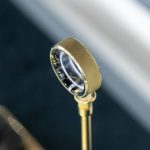Hearing is one of our five senses. It helps connect us to the world and a loss of hearing is independently associated with an increased risk of dementia.1 Researchers2 have also found that loud leisure activities and music are common causes of tinnitus and hearing loss.
A study3 published in BMJ Global Health finds a link between unsafe listening practices using earbuds and hearing loss, which may place over 1 billion young people aged 12 to 34 years at risk of hearing loss.
An early sign of hearing loss is tinnitus. This is not a specific disease but, rather, a symptom of an injury or abnormality in the auditory system. People who have tinnitus describe it as a ringing in the ears, but it can also sound like roaring, clicking, hissing or buzzing. Several health conditions can trigger tinnitus, such as a simple obstruction blocking the ear canal, sinus infection, brain tumor, hormonal changes or thyroid abnormalities.
For many, tinnitus is the first sign of hearing loss. Cleveland Clinic audiologist Sarah Sydlowski compares the condition to phantom limb pain.4 When the inner ear is damaged, it tries to function and starts producing sounds to replace what you should hear naturally. The inner ear is highly vascularized with tiny arteries that provide the area with nutrition and oxygen. When the blood supply is interrupted, it damages the structures, which is how loud noises can affect hearing.
In some cases, patients have had good results with sound therapy and tinnitus retraining, but the evidence remains inconclusive. Avoiding loud noises helps prevent the development and progression of tinnitus that has an adverse effect throughout life.5
1 Billion May Be at Risk of Hearing Loss
The researchers sought to determine how unsafe listening practices in people using personal listening devices, or earbuds, and attending loud entertainment venues aged 12 to 34 years may affect hearing loss.6 To estimate the number of young people who might be at risk for hearing loss worldwide, they searched through three databases of peer-reviewed articles that were published between 2000 and 2021.
They evaluated the risk of hearing loss across 33 studies and 19,046 individuals, then estimated the number who could lose their hearing by considering the estimated number of 12 to 34-year-olds in 2022 and the best estimates across the studies of those who are exposed to loud noise at entertainment venues and on personal listening devices. Based on those figures, they calculated the potential risk of hearing loss from 0.67 to 1.35 billion young people.
Study Finds7 notes that past research has revealed many who wear earbuds or headphones listen to music at levels as high as 105 decibels, which is roughly the sound level at entertainment venues. This is well above the safe upper range of 80 decibels for adults and 75 decibels for children. The researchers appear to call for the enforcement of noise regulations, concluding:
“Unsafe listening practices are highly prevalent worldwide and may place over 1 billion young people at risk of hearing loss. There is an urgent need to prioritise policy focused on safe listening. The World Health Organization provides comprehensive materials to aid in policy development and implementation.”
A 2022 study8 of medical students whose mean age was 21 years also evaluated hearing loss as it may be linked to personal listening devices, including earbuds and headphones. In the group of 221 men and women, 96.4% regularly used electroacoustic devices and 73.8% preferred earbuds.
Daily listening exceeded one hour in 78.8% of the group and the men listened more than the women, although the noise level did not vary significantly. The data showed mild sensorineural hearing loss in one-third of the young people who used personal listening devices.
Noise Pollution Increases Risk of Heart Attacks and More
Although researchers have studied the health effects of air and water pollution over the last several decades, they have only begun to delve into the effects of noise and light pollution. A study9 presented at the American College of Cardiology Annual Scientific Session in 2022 revealed data that blames noise pollution on 1 in 20 heart attacks.
At the most basic level, noise pollution is defined as sound in the environment that has potential effects on sleep, hearing damage and stress levels.
Sources can include construction, vehicles and industrial sounds like generators, compressors and train station traffic. The noise can also come from personal listening devices or from natural sounds like cicadas or birds. Many overlook the potential health hazard, although it is a major problem in urban areas and more widespread than in past years.10
Researchers gathered data11 from nearly 16,000 patients hospitalized in 2018 for a heart attack in New Jersey. They used the patient’s home address to calculate the daily noise level and separated those who lived in high levels of transportation noise with an average of 65 decibels or higher and those who lived in areas with low exposure with an average of 50 decibels or less.
When the data were extrapolated, the heart attack rate was 3.3% in levels with higher noise as compared to 1.9% in quieter areas. The data showed exposure to high levels of noise was associated with approximately 5% of all heart attacks in busy cities. Besides increasing your stress levels, outdoor sound noise pollution can also keep you from falling asleep and/or staying asleep.12
The EU Research and Innovation Magazine13 calls noise pollution “one of the biggest health risks in city life.” Because your brain is always monitoring the environment for sounds that indicate danger,14 continued exposure affects your sensitivity. If you feel unable to control the noise in your environment, it can have an impact on your mental health.
Experts also believe that noise pollution influences cognitive function.15 Living in urban areas with steady exposure to noise pollution can impair a child’s development and have a lifelong effect on overall health. A study released by the WHO in 2011 used 10 years of data and found at least 1 million healthy years of life in Europe are lost due to noise pollution.
Studies in children who are exposed to environmental noise have consistently demonstrated an effect on cognitive performance.16 A more recent 2015 study17 noted that while environmental noises don’t usually affect children’s hearing, “increasing use of personal electronic devices may leave some children exposed to harmful levels of noise.”
Once the damage is done, poor hearing also increases the risk of social isolation, depression and dementia. Unfortunately, fewer than 30% of people over age 70 who have a hearing loss will wear hearing aids,18 even though data19 gathered by the University of Exeter and King’s College London demonstrated how wearing an effective hearing aid can reduce the risk of developing dementia.
Wireless Earbuds Also Raise Risks of EMF Damage
As the data show,20 most young people prefer using earbuds. It’s crucial to note that wireless earbuds also increase your risk of EMF. This includes any wireless Bluetooth device, such as AirPods, or any wireless Bluetooth headphones.
While they offer a higher level of function and convenience, it comes at a cost. In 2015 — and updated in 2022 — 250 scientists worldwide signed a petition21 to the United Nations as an international appeal, addressing the nonionizing EMF emitted from these devices. For decades the industry has claimed that nonionizing radiation is harmless and the only radiation worth worrying about is ionizing radiation. On the contrary, these scientists state:22
“Based upon peer-reviewed, published research, we have serious concerns regarding the ubiquitous and increasing exposure to EMF generated by electric and wireless devices.
These include — but are not limited to — radiofrequency radiation (RFR) emitting devices, such as cellular and cordless phones and their base stations, Wi-Fi, broadcast antennas, smart meters and baby monitors as well as electric devices and infrastructures used in the delivery of electricity that generate extremely low frequency electromagnetic field (ELF EMF).”
The petition notes the International Agency for Research on Cancer classifies EMF as a possible human carcinogen. They include numerous scientific publications that show EMF affects organisms at levels “well below” most international and national guidelines. Among the potential risks of exposure are:23
Cancer
Cellular stress
Genetic damages
Structural and functional changes in the reproductive system
Negative impacts on general well-being
Increase in harmful free radicals
Learning and memory deficits
Neurological disorders
By failing to act, the petition states, the World Health Organization is “failing to fulfill its role as the preeminent international public health agency,” adding that damage from EMF “goes well beyond the human race, as there is growing evidence of harmful effects to both plant and animal life.”
Wireless earbuds could be particularly dangerous since the technology is so new that the potential neurological effects have not been sufficiently researched. Joel Moskowitz, Ph.D., University of California, Berkeley, and one of the petition’s signers stated in a news release:24
“I couldn’t imagine it’s all that great for you,” noting that AirPods “communicate with one another using a magnetic induction field, a variable magnetic field [one] sends through your brain to communicate with the other.”
Protect Your Hearing and Lower Your EMF Exposure
It is crucial to protect your hearing and lower your exposure to EMF. Wearing earbuds can sometimes force ear wax back further down the ear canal. Your ears are normally self-cleaning, but earbuds can create an obstacle for your ears to move ear wax. Note: Cotton swabs are not the way to remove ear wax as they create some of the same challenges by pushing ear wax further down the canal.
There’s also a risk of eardrum perforation. In one study,25 a sample of emergency department records showed 61.2% of people treated for traumatic perforation had caused the injury themselves by sticking things in their ear, and 44.9% of those things were cotton tip swabs.
Other mistakes you may be making is cleaning your ears regularly since ear wax is beneficial and protects and lubricates the ear canal. Don’t insert any type of device into the ear canal and avoid ear candling,26 which is the process of using a hollow, cone-shaped device and lighting a fire.
Using wireless earbuds, even at lower decibels to protect your hearing, can negatively affect your brain. Here are more ways that can help reduce your EMF exposure and mitigate damage from unavoidable exposure.
1. Identify major sources of EMF, such as your cellphone, cordless phones, Wi-Fi routers, Bluetooth headsets and other Bluetooth-equipped items, wireless mice, keyboards, smart thermostats, baby monitors, smart meters and the microwave in your kitchen. Ideally, address each source and determine how you can best limit their use.
2. Barring a life-threatening emergency, children should not use a cellphone or a wireless device of any type. Children are far more vulnerable to cellphone radiation than adults because of their developing immune systems and brains and thinner skull bones.
3. Connect your desktop computer to the internet via a wired Ethernet connection and be sure to put your desktop in airplane mode. Also avoid wireless keyboards, trackballs, mice, game systems, printers and portable house phones. Opt for the wired versions.
If you must use Wi-Fi, shut it off when not in use, especially at night when you are sleeping. Ideally, work toward hardwiring your house so you can eliminate Wi-Fi altogether. If you have a notebook without any Ethernet ports, a USB Ethernet adapter will allow you to connect to the internet with a wired connection.
Avoid using wireless chargers for your cellphone, as they also increase EMFs throughout your home.
4. Shut off the electricity to your bedroom at night. This typically works to reduce electrical fields from the wires in your wall unless there is an adjoining room next to your bedroom. If that is the case you will need to use a meter to determine if you also need to turn off power in the adjacent room.
5. Use a battery-powered alarm clock, ideally one without any light. I use a talking clock for the visually impaired.
6. If you still use a microwave oven, consider replacing it with a steam convection oven, which will heat your food as quickly and far more safely.
7. Avoid using “smart” appliances and thermostats that depend on wireless signaling. This would include “smart” TVs. They are called smart because they emit a Wi-Fi signal and, unlike your computer, you cannot shut the Wi-Fi signal off. Consider using a large computer monitor as your TV instead, as they don’t emit Wi-Fi.
8. Refuse a smart meter on your home as long as you can, or add a shield to an existing smart meter, some of which have been shown to reduce radiation by 98% to 99%.27
9. Consider moving your baby’s bed into your room instead of using a wireless baby monitor. Alternatively, use a hard-wired monitor.
10. Replace CFL bulbs with incandescent bulbs. Ideally, remove all fluorescent lights from your house. Not only do they emit unhealthy light, but more importantly, they will transfer current to your body just by being close to the bulbs.
11. Avoid carrying your cellphone on your body unless in airplane mode and never sleep with it in your bedroom unless it is in airplane mode. Even in airplane mode, it can emit signals, which is why I put my phone in a Faraday bag.
12. When using your cellphone, use the speakerphone and hold the phone at least 3 feet away from you. Seek to radically decrease your time on the cellphone. Instead, use VoIP software phones that you can use while connected to the internet via a wired connection.
13. Avoid using your cellphone and other electronic devices at least an hour (preferably several) before bed, as the blue light from the screen inhibits melatonin production.28
14. The effects of EMFs are reduced by calcium-channel blockers, so make sure you’re getting enough magnesium. Most people are deficient in magnesium, which will worsen the impact of EMFs.
15. Martin Pall, Ph.D., published a paper29 suggesting that raising your level of Nrf2 may help ameliorate EMF damage. One simple way to activate Nrf2 is to consume Nrf2-boosting food compounds such as sulforaphane-containing cruciferous vegetables.
Other foods that boost Nrf2 include those high in phenolic antioxidants, long-chained omega-3 fats DHA and EPA, carotenoids (especially lycopene), sulfur compounds from allium vegetables, isothiocyanates from the cabbage group and terpenoid-rich foods. Exercise and calorie restriction (such as intermittent fasting) will also raise Nrf2.
16. Molecular hydrogen has been shown to target free radicals produced in response to radiation, such as peroxynitrites. Studies have shown molecular hydrogen can mitigate about 80% of this damage.30
Certain spices may help prevent or repair damage from peroxynitrites that are produced with exposure to EMF. Spices rich in phenolics, specifically cinnamon, cloves, ginger root, rosemary and turmeric, have exhibited some protective effects against peroxynitrite-induced damage.



